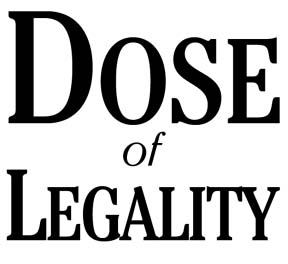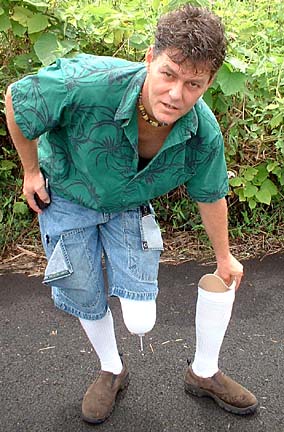
Honolulu lawyer Charles Ferrera was careful last month about how to ask a Big Island jury to compensate his client for his leg amputation resulting from a doctor's faulty diagnosis.
How Hawaii lawyers navigate around
the state's cap on awards for pain and
suffering to get the best deals for
their medical malpractice clientsBy Lee Catterall
lcatterall@starbulletin.comFerrera's strategy in the case illustrates how lawyers deal with Hawaii's narrowly tailored cap on amounts to be awarded to victims of medical malpractice and how federal legislation would severely restrict those amounts. Doctors say they need those restrictions to keep their soaring insurance premiums from forcing them to take down their shingles.
Peter Wade had endured excruciating pain during the weeks leading up to the removal of his left leg just below the knee in 1999. However, Hawaii law limits the amount that can be awarded for physical pain and suffering to $375,000 to plaintiffs in cases of medical malpractice.
Ferrera asked that Dr. Rachel Tortolini and the Bay Clinic in Hilo be ordered to pay larger amounts for the mental anguish, disfigurement and loss of enjoyment of life that the 39-year-old former carpet layer would suffer. No statutory cap exists in those areas.
COURTESY OF PETER WADE
Jurors awarded Peter Wade of Hilo nearly $1.1 million, including $350,000 for physical pain and suffering -- $25,000 below the legal limit. "They gave me exactly what I had wanted," his lawyer, Charles Ferrera, said.
"Anything above $375,000 (in pain-and-suffering damages) I don't get," Ferrera says. "I made sure that my arguments were going to keep me clear." The jury was not made aware of the limit, but the judge advised attorneys that she would impose the cap if the panel returned a verdict that exceeded it.
Jurors came back with an award of nearly $1.1 million, including $350,000 for physical pain and suffering -- a safe $25,000 below the limit.
"They gave me exactly what I had wanted," Ferrera says.
If Wade's misfortune had occurred in California, his entire compensation would have been little more than one-third of what the Hawaii jury decided was appropriate.
The Bush administration is calling on Congress to enact legislation modeled after the California law, citing skyrocketing doctors' insurance premiums. The California law places a $250,000 limit on all non-economic damages. Economic damages are calculated specifically from such items as medical bills or estimates of past and projected lost wages.
One-year increases in medical malpractice premiums for the three major specialties -- internal medicine, general surgery and obstetrics-gynecology -- averaged 30 percent last year in at least eight states. Surgeons in many states face high five-figure premiums for malpractice coverage, while obstetricians in a few states pay annual premiums of more than $100,000.
Medical malpractice premiums in Hawaii last year averaged $7,156 for internists, $25,756 for general surgeons and $42,928 for obstetricians, according to the Medical Liability Monitor, which keeps track of rates. The Bush administration cites those relatively low rates in Hawaii and eight other states, including California, as being held in check by "reasonable limits on non-economic damages."
However, Hawaii's $375,000 cap, enacted in 1995, is so confined -- covering only "actual physical pain and suffering" -- that it is almost inconsequential, says plaintiffs' lawyer Robert Merce.
"The $375,000 cap is pretty unimportant," says Merce. "Most of the pain and suffering that you undergo if you've got a long-term problem is mental pain and suffering, and there's no limit on that. That gives jurors the opportunity to award a lot of money in general (non-economic) damages.
"I've tried quite a few medical malpractice cases," Merce says, "and we never paid any attention to that $375,000 cap. We didn't tell the jury about it. It just wasn't a big deal."
"It's really nothing," agrees Norman Slaustas, executive vice president of the Hawaii Association of Physicians for Indemnification, or HAPI, a cooperative of more than 400 doctors that provides medical malpractice coverage to members.
Slaustas attributes Hawaii's lower premium rates to trends that have long existed in other economic areas in which the islands follow the mainland by several years.
"I think five years from now or three years from now we're going to be just as high as the mainland is," Slaustas says. "Within the last number of years you've seen malpractice premiums and the malpractice awards increasing at a significant rate." HAPI's assessment of members increased by 5 percent last year, he says.
Lawyer and consumer groups blame insurance companies for raising premiums to offset low returns on insurers' investments.
"Insurance was cheaper in the 1990s because insurance companies knew that they could take a doctor's premium and invest it, and $50,000 would be worth $200,000 five years later when the claim came in," says Victor Schwartz, general counsel to the American Tort Reform Association. "An insurance company today can't do that."
The increases in medical malpractice premiums have not been caused by high jury awards, says Merce. "The premiums track the (stock) market," he says. "Premiums do not track judgments, and judgments are not going up significantly anywhere. The reason that insurance companies are putting the squeeze on doctors is because of their (lower) return on investment and the fact that a lot of them went bankrupt or pulled out of the medical malpractice business when the stock market turned down, and that left a couple of insurers with no competition."
Merce says he believes premiums paid by Hawaii doctors may be relatively low because of the conservative investment polices of HAPI and the Medical Insurance Exchange of California, a physician insurance company that covers about 1,300 doctors in Hawaii, about half of those in practice in the state.
"I think that's untrue," says Slaustas. "The insurance companies invest in bonds, not in equities, generally, so most of their money is in very safe, high-grade government or corporate securities. I don't think there's any basis for that argument."
Slaustas says the threat of medical malpractice lawsuits also is driving up the cost of health care.
"Doctors are very sensitive to medical malpractice issues," he says, "and to avoid them they may give more tests than they would generally, and the public has to pay for that."
President Bush and Governor Lingle have blamed frivolous medical malpractice lawsuits for the premium increases.
"There are too many lawsuits filed against doctors and hospitals without merit," the president said in a Jan. 16 speech in Pennsylvania.
Five days later, Lingle said in her State of the State address that premiums had "increased substantially" in Hawaii. "Some of the increase," she said, "is due to frivolous lawsuits filed by people who see our courts as one giant slot machine." She proposed that a panel of independent doctors and lawyers review lawsuits to eliminate those "without merit."
The state Medical Claims Conciliation Panel, part of the state Department of Commerce and Consumer Affairs, already conducts such reviews and identifies meritless cases, although it lacks the power to prevent lawsuits from being filed.
"We have pre-trial screening," Slaustas says, "and a lot of cases are weeded out."
Merce and Ferrera maintain that Bush's and Lingle's assertions about frivolous lawsuits are preposterous.
Merce says plaintiffs' attorneys are not "trying to hit the slot machine and the big judgment, because they're settling cases and not taking them to trial because of the risk of loss.
"It isn't like the picture that's being portrayed, of plaintiffs' lawyers taking case after case to trial, figuring you can lose five and if you hit with a crazy jury on one, you're going to make it all back," Merce says. "The reality is no one's taking these cases to trial. They're settling them, because everyone's afraid of juries."
Lawyers spend from $25,000 to $100,000 in legal work on a single case, Ferrera says, and clients don't have the money to compensate them in case the lawsuit fails. Seventy percent of medical malpractice trials are won by the defense, he says.
"Who is going to bring a crappy med-mal practice case?" Ferrera asks. "Only an idiot. And then, very soon, you'll be an idiot without money.
"The cases that go to trial, sometimes they're close," he says, "but they're not frivolous, and nobody's holding up any doctors."
Very few cases reach the trial stage. In the last fiscal year, 478 lawsuits claiming personal injuries or property damage not resulting from motor vehicles were filed on Oahu, adding to the 908 cases pending. Of those, 500 were dismissed or settled and only six cases went to trial, according to court records.
Both sides of the issue agree that limits similar to those in California would have a significant effect in Hawaii if adopted by the Legislature or Congress. The California law, enacted in 1975, limits all non-economic damages to $250,000.
In the Big Island case, Ferrera asked for and got a verdict that included $900,000 in non-economic damages and nearly $200,000 in economic damages. If the California restrictions had been in effect, the total verdict would have been less than $350,000.
State Sen. Sam Slom has introduced a bill modeled after the California law, but it has not received serious consideration.
The U.S. House last month approved a bill that would impose the $250,000 limit nationwide. However, the legislation -- which goes beyond the California law by extending protections to HMOs, pharmaceutical firms and manufacturers of medical devices -- faces hurdles in the Senate.
Sen. Dianne Feinstein of California has been the only Democrat in the Senate to support the caps, but she withdrew her name from the legislation after the House action because of doctors' unwillingness to compromise. Feinstein had worked with Republican leaders, including Majority Leader Bill Frist, a surgeon, to limit awards to $500,000. California's cap of only half that amount has not been adjusted for inflation since its enactment in 1975. Without Feinstein's support, the bill is thought to be in danger.

